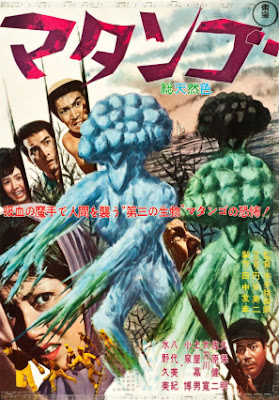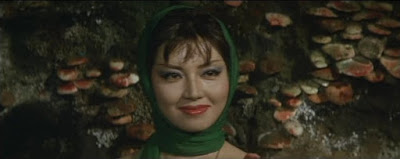(1963) Directed by Ishirô Honda; Written by Takeshi Kimura;
Adaptation by Shin'ichi Hoshi and Masami Fukushima; Based on the story “The
Voice in the Night,” by William Hope Hodgson; Starring: Akira Kubo, Kumi Mizuno,
Hiroshi Koizumi, Kenji Sahara and Hiroshi Tachikawa; Available on DVD (Out of
Print)
Rating: ****
“Normally in a kaiju or a Godzilla film the kaiju is the
main character and we act around it. But in this one, we’re on a creepy
shipwrecked boat with a group of seven people, all with different
personalities.” – Akira Kubo (from DVD commentary)
Ishirô Honda has becomes so synonymous with Toho’s kaiju
flicks that it’s easy to forget his other films and contributions to cinema.* Not
to denigrate his association with his depictions of giant monsters causing mass
destruction, but Honda proved his versatility telling a variety of stories with
science fiction as his canvas. One such example is Matango, released in the U.S. under the title Attack of the Mushroom People. In fact, it was that
sensationalistic title (and one-star TV page listings) that scared me away from
watching it for years. When I finally rented the DVD decades later, I was
surprised by the atmosphere, depth and brooding tone of this underappreciated
film.
* Over the years, Honda collaborated with Akira Kurosawa
as assistant or second unit director on several of his films, including Ran and Dreams.
Matango is
often lauded for its “Lovecraftian” vibe, but the source material actually pre-dates
most of H.P. Lovecraft’s fiction. The film was based on William Hope Hodgson’s
1907 short story, “The Voice in the Night,” which in turn was adapted by Masami
Fukushima and Shin'ichi Hoshi for their story “Matango,” and Takeshi Kimura’s
subsequent screenplay. Honda filmed Matango
on the islands of Izu Ōshima and Hachijō-jima to simulate the remote tropical
locale in the story.
Imagine Gilligan’s
Island if the focus was on distrust, discord and paranoia among the
castaways, all governed by some hideous malevolent force. The film opens with
college professor Kenji Murai (Akira Kubo) in a hospital, recounting his
experiences as the sole survivor of a doomed pleasure cruise. Seven
individuals, including an egotistical corporate president (Yoshio Tsuchiya), a
virtuous college professor (Kubo), a flirty singer (Kumi Mizuno), naïve college
student (Akiko Sôma) and a self-centered mystery writer (Etsurô Yoshida) embark
on a cruise aboard a new yacht. Everyone’s having a good time - Mami (Mizuno)
takes a moment to serenade the crew with an impromptu song (Well, nominally a
song, if you consider “La, la, la la” a valid substitute for lyrics). Not
unlike the aforementioned classic television comedy, however, the weather gets
rough, and before you know it the passengers and crew are lost at sea.
Eventually, they become stranded on a remote South Pacific island. When they discover
an abandoned research vessel, they attempt to unravel the mystery about what
happened to the ship’s crew. Before long, as tension mounts, their fate seems
to be headed in a similar direction. They soon face starvation after they
plunder the ship’s meager rations and forage for the scarce food sources on the
island. Suddenly the prospect of eating the strange, but abundant mushrooms
that proliferate around the island doesn’t sound bad, compared to the
alternative.
Shigekazu Ikuno and Akira Watanabe deserve kudos for
their excellent production and art design, which contribute immensely to the
atmosphere. The derelict ship exteriors and interiors are particularly
convincing. The passageways are encrusted with fungal growth, suggesting the
ship has become a living thing. A colorful forest of mushrooms takes on an
otherworldly appearance. The effects crew experimented with chemicals to make
mushrooms that grew on demand, and created rice pastry mushrooms for the cast
to eat when their respective characters had the onscreen munchies. The unique
makeup effects depict people in various states of transformation, as they
undergo a metamorphosis into something not quite human, nor quite mushroom.
Matango explores
the darker side of the human soul, brought to the surface by isolation and suppressed
urges. As the film progresses and things become more desperate, the castaways
become more inhuman in their behavior – or is it their true human nature,
brought to the surface? Eating the mushrooms result in a loss of inhibitions,
as violent and/or sexual urges break free, as exemplified by Mami’s seductive behavior
toward the male castaways. The mushrooms themselves, and their phallic shapes,
suggest the physicality of lust and desire. But what lies underneath the final,
terrifying distorted human forms and twisted behaviors are nothing new. The
monsters are us, reinforced by Kenji’s final, sobering monologue.
Honda and company do an admirable job capturing the
overwhelming feeling of dread that permeates Hodgson’s original story. For
anyone who might have doubted Honda’s mettle as a multifaceted director, I
present Matango as a rebuttal. This
thoughtful mood piece deserves more acclaim as a genre high point. Sadly, the
excellent DVD from Tokyo Shock is out of print, so it might take some tracking
down, but it’s well worth the investment.








I've always been pleased I snagged a copy of that Tokyo Shock DVD before it became scarce. Weirdly, I was kind of disappointed the first time I watched it because I was expecting something sillier. Took a second watch to enjoy it on its own merits. It does indeed boast pretty great production design.
ReplyDeleteMy thoughts, exactly. Because the silly American title was stuck in my brain, I was expecting something really cheesy and unintentionally funny. Boy, was I mistaken.
DeleteI recall we discussed Godzilla Vs Hedorah on Twitter a while back - any chance on a post for Japan-uary? I've been edging closer and closer to earmarking that for a Dog Farm live event. Side note: I originally bought that Matango disc - having not yet seen it - with the intent of using it for a live event. Though I personally enjoyed it, I deemed it too dour for that crowd. lol
ReplyDeleteWith its timely environmental message, Godzilla V Heorah would be a perfect addition to Japan-uary. Sadly, I won't be able to review it this time around, but I think it would be great to add this to the slate of reviews for Japan-uary VII next year. Thanks for the suggestion.
DeleteOn a side note, have you considered Funky Forest: First Contact or The Calamari Wrestler? I think either of those flicks would make a big splash at your event. Cheers!
Love this movie! The source material is satisfyingly creepy as well. You don't see this mentioned a whole lot, but it's worth checking out Masayuki Ochiai's movie Infection (Kansen). I think it owes quite a bit to Matango.
ReplyDeleteGreat stuff. Thanks for the tip. I need to check that out!
Delete